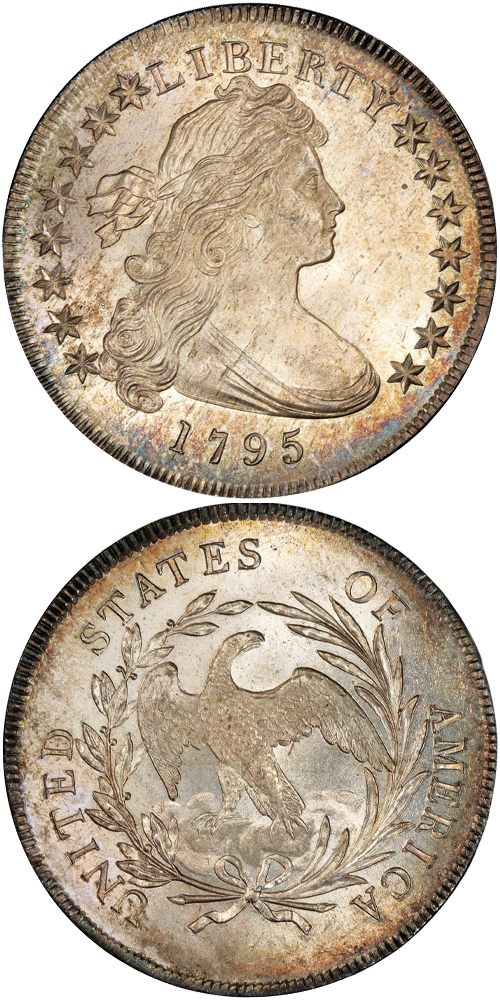1795 Draped Bust Dollar
Off Centered Bust
When Henry William DeSaussure became Mint Director in June of 1795, he set two goals: to get gold coins to actively circulate and to improve the appearance of each denomination, with particular attention to the silver coinage. DeSaussure contracted with famed portrait artist Gilbert Stuart to prepare a depiction of Liberty to replace Robert Scot's Flowing Hair bust. Stuart's design, believed by some to have been a drawing of Ann Willing Bingham of Philadelphia, was then transferred into plaster models and punches by John Eckstein for Scot. Eckstein also prepared improved versions of the Small Eagle reverse punches that showed the eagle in intricate detail and style. For this work Eckstein was paid $30 in September. The resulting Draped Bust, Small Eagle silver dollar is often heralded as a masterpiece from the early United States Mint, with Eckstein "deserving of a niche in the Pantheon of numismatic notables," as Q. David Bowers writes in The Encyclopedia of United States Silver Dollars: 1794-1804 (2013). DeSaussure's tenure at the Mint was very short; in October of that same year, he resigned his position due in part to illness and general dissatisfaction. While only there for a few months, he made a long-lasting impression on the nation's coinage. While the Small Eagle reverse would only be employed until 1798, the Stuart/Eckstein Draped Bust was used for the rest of the series until coinage of silver dollars was suspended sometime in 1804.
Two different die combinations were used for the 1795 Draped Bust dollar. The die pair believed to have been struck first is the so-called Off-Center Bust variety, BB-51, which features Liberty appearing too far to the left from the center, a position used only on this die pair. This positioning was corrected to a more aesthetically pleasing centered location on the second variety, the BB-52 pair. The precise number struck and timing of each variety is unclear. Mint records from the time are not as thorough as scholars would like and much of what can be determined is conjecture. The commonly cited mintage figure of 42,738 is believed to be only a portion of the overall total for the 1795 Draped Bust dollar. Bowers posits that somewhere in the vicinity of 100,000 coins were produced of both BB-51 and BB-52 and that while the first deliveries likely took place in October, the later deliveries could have extended into 1796. In fact, the reverse die used for BB-52 was used as late as 1798, lending credence to this being the later of the two varieties.
BB-51 is the more plentiful of the two die marriages of this issue, and Bowers suggests that 1,400 to 2,000 coins are extant in all grades. With the typical survivor grading VF, however, even EF and AU coins are scarce in an absolute sense, and rare relative to the demand for them in today's numismatic hobby. Mint State examples are rare by any measure.
The example to the left was sold by Stack's Bowers Galleries in the D. Brent Pogue Part IV Auction, where it realized $763,750.






